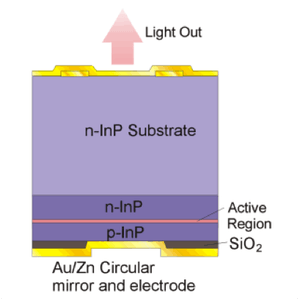Free Space Optics (FSO) VCSEL & Laser Comparison
Summary
What does VCSEL mean and how do they compare with other laser technologies? Why do some FSO vendors choose to use VCSELs?
Some commercial Free Space Optics (Optical Wireless, FSO, Laser Link, Infrared) products have been built using VCSEL devices. The low output power means that the FSO products are limited in range and have narrow beams, which causes alignment and stability problems in practical use. For the reasons shown below, FSO using VCSEL has serious limitations and therefore laser-based FSO is generally considered to be superior. Laser-based FSO has longer range, wider beamwidth which translate to higher availability, uptime, and link stability.
VCSEL technology
VCSEL is shorthand for “vertical-cavity surface-emitting laser”. The laser is designed using a vertical cavity, and, as a surface emitter, it spews light out of its top surface. This sets VCSELs apart from all other lasers, classed as edge-emitters, which have a cavity that lies in the plane of the wafer (usually thought of as horizontal) and emits light out of the side.

VCSELs operating at 850 nanometers have become popular in Local Area Networks for a few factors. At 850nm, VCSELs are cheap, and offer high bandwidths. Here are the details:
- VCSELs emit a uniform, narrow, circular beam, which simplifies optical system design considerably. It’s easy to couple into a fiber — coupling efficiencies into a fiber are upwards of 80 per cent. In contrast, edge-emitters have an elliptical beam, which is strongly divergent.
- A VCSEL laser cavity is very short, compared to that of an edge-emitter. So, when the laser is turned off, it takes less time for the remaining light to exit the cavity. As a result it is possible to modulate the laser (turn the beam on and off) directly, which avoids the need for an external modulator. Devices with direct modulation speeds of 2.5 Gbit/s are commonplace.
- VCSELs are very efficient at turning electricity into photons. The record is 57 per cent, but typical efficiencies are in the region of 6 to 25 per cent. As a result they consume less electrical power than an equivalent DFB (distributed feedback) laser. For example, a DFB laser might draw 60 milliamps, while a VCSEL would only require 15 mA to produce the same optical output.
False arguments used in favour of VCSELs
Beware a false argument used by some vendors:
“Since they dissipate less electrical power as heat, VCSELs don’t require temperature control. That saves money by eliminating the need for a Peltier cooler or other cooling device and the associated circuitry” – this is NOT true
Telecom reliability tests question VCSEL reliability, because the failure mechanism is abrupt – the transition from ‘working’ to ‘failed’ is very rapid. For this reason, VCSEL devices are often required to be ‘redundant’, operating with N+1 standby, due to fundamental reliability requirements.
Known Problems with VCSELs for FSO
- VCSELs offer only very low output power of 1-10mW. Higher power devices are not available. This limits the range performance of FSO links built using VCSEL devices
- VCSELs have an abrupt failure mechanism. Long-term-reliability at moderate-to-high temperatures is a problem, and hence VCSELs have been dominant in LAN environments and not in telecoms, where high reliability is paramount. The failure mechanism could be a problem for FSO link users, with no notice of impending device failure. By comparison, Laser-based FSO devices have a gradual “fade” which is predictable and can be monitored.
- Limited choice of wavelengths. The materials used to make 850nm VCSELs are not yet applicable to longer wavelengths. Currently, commercial VCSELs that operate at the wavelengths of 1310 or 1550 nm have yet to become generally available.
For Further Information
Please Contact Us
You must be logged in to post a comment.